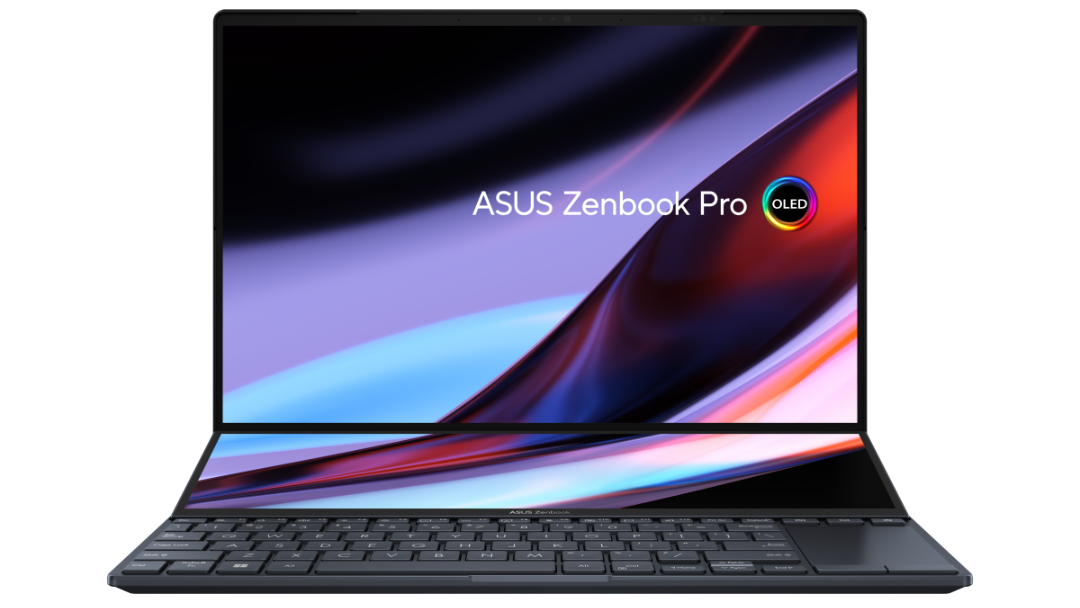The idea of adding more displays to a notebook is one that manufacturers have toyed with for some time. The best solution we’ve seen is an external monitor but even this isn’t an ideal solution.
Enter the ASUS Zenbook Pro 14 Duo OLED which sports a main 14.5 inch display as well as a 12.7 inch ScreenPad which doubles as a second display. The keyboard and a small touchpad fills up the rest of the chassis but ASUS has a trick up its sleeve. The ScreenPad tilts up slightly so that you are not only able to see it more easily, but make use of it.
This is what we found when we kicked the new Zenbook Pro 14’s tyres.
Performance
Inside this engineering marvel you will find a 12th Gen Intel Core i9-12900H processor with 32GB of DDR5 RAM on backing vocals. The GPU present here is an NVIDIA RTX 3050Ti GPU which is running the NVIDIA Studio drivers out of the box. Sure, you could game on this notebook but we wouldn’t advise buying it for that purpose.
Running the notebook through Cinebench R23 we scored an incredible 13 797 pts in the multi-threaded benchmark and 1 896 pts in the single-thread benchmark.
As for gaming performance, as we mentioned this isn’t a gaming notebook but we switched to Game Ready drivers and achieved a score of 5 967 just to showcase this isn’t for games.
In terms of heat, the fact that the ScreenPad lifts up and allows for more air to flow over the CPU and GPU is great, we only saw a peak of 85 degrees Celsius on the CPU which is fantastic considering how thin the ASUS Zenbook Pro 14 Duo OLED is and how well it performs.
The benefit of this is that there is next to no warm air hitting your hands as you type and there is a bit more cooling left in the tank for hotter environments.
Overall, performance is good although somewhat let down by the GPU which is lacking in the performance department.
About those displays
As mentioned, the marquee feature of the ASUS Zenbook Pro 14 Duo OLED are the dual OLED displays. We should also mention that they are both touch-enabled and run at a 120Hz refresh rate.
The ScreenPad (the thinner display here) is powered by ScreenXpert software which means you can customise it with a variety of shortcuts to easily access apps, flick windows from one display to another and more. The MyASUS feature is here as always to make taking calls seamless but really, the ScreenPad is best used as a secondary display.
While writing, it’s incredible to have source material just below what you’re working on and the touch functionality makes navigating the apps and web pages so simple. ASUS also includes a stylus although you will have to store it in your bag as there is no garage for it. It works well and if you have greasy fingers you may want to stick to using the stylus for navigation purposes.
The ScreenXpert software does come in handy if you want to launch apps natively on the ScreenPad. For instance, we configured the software so that Discord would always launch on the ScreenPad through the app navigator and it worked a treat.
More still, ASUS includes an app called Control Panel which supports Adobe software. Depending on that app you’re using, a different set of controls can be launched. Adobe Premiere, After Effects, Lightroom Classic, Illustrator and Photoshop are all supported here.
Not only is the display cleverly engineered, it’s useful which we’d argue is the most important thing. Had this simply been a pared down display with no touch functionality, high refresh rate or indeed ScreenXpert, we’d file this under “Gimmick”. ASUS has, however, done a stellar job here and we can’t help but be impressed.
The main display is rather gorgeous featuring a 2880 x 1800 resolution. Both displays cover 100 percent of the DCI-P3 colour gamut. The main display is slightly brighter at 550-nit and the ScreenPad is dimmer but still bright at 5000-nit. This is a noticeable difference but not one that spoils the experience.
Battery and sundry
Despite having two displays to power, the battery in the ASUS Zenbook Pro 14 Duo OLED managed to eke out six hours of power while streaming Full HD content on Netflix. Your mileage may vary depending on your use case. Something we are concerned about is the battery life over a long period of time. Unfortunately we can’t test this but it’s something you should keep in mind considering the unique nature of this notebook.
The keyboard is serviceable but you will want to use an external keyboard and a mouse even with the included stylus.
As for ports, you won’t be left wanting with multiple USB 3.2 Type-A ports, an HDMI 2.1 port, combo headphone microphone jack and even an SD card reader.
Conclusion
While not a gaming machine or a content creation beast, the ASUS Zenbook Pro 14 Duo OLED is fantastic for productivity on the move. For those like us who just need a little extra screen real estate during loadshedding or while travelling, the ASUS Zenbook Pro 14 Duo OLED is a gift from above. However, with pricing in the region of R45 000, this is a convenience you are really going to have to justify.
Not that it will be tough to do so because the ASUS Zenbook Pro 14 Duo OLED is a great notebook. We would love to see an option for a beefier GPU in future but we also understand that one can only cram so much power into a 14inch chassis.
While it’s tough to recommend this notebook to all given its unique engineering, we can recommend the ASUS Zenbook Pro 14 Duo OLED if you need two displays and you’re away from your desk more often than not.




